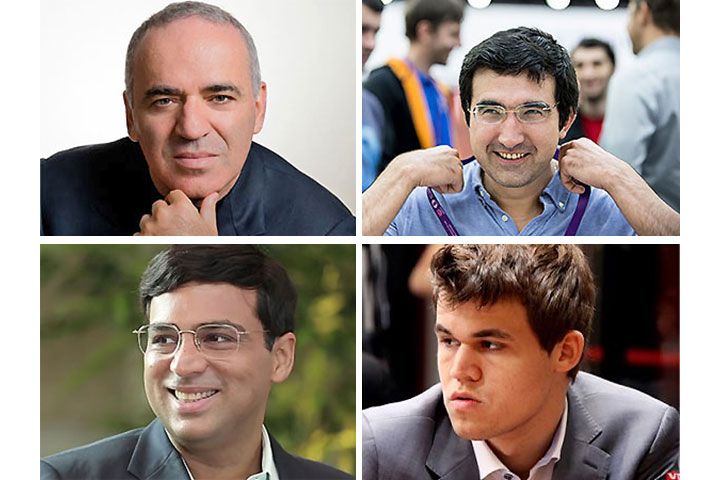


Vladimir Kramnik is a prime example for a universal player. He has made numerous contributions to opening theory, he is well-versed in all kinds of openings, and he is always excellently prepared. In the course of his career Kramnik has played a lot of brilliant attacking games but he has won even more games through his clear, logical positional play and his fantastic endgame abilities. He is particularly strong in queenless middlegame positions.
In this regard the following game is typical for Kramnik. His opponent does not show much ambition with White, Kramnik has no problems to equalise with Black, and seizes the initiative soon after the opening. After an early exchange of queens Kramnik takes no chances and wins smoothly.
Garry Kasparov might well be the strongest player in the history of chess. In 1985 he became World Champion - at the age of 22, the youngest World Champion of all times. When he declared his withdrawal from tournament chess in March 2005 he had an Elo-rating of 2812 and still was the world's number one.
Kasparov's opening preparation, his tacticals skills, and his ability to calculate variations incredibly fast and deep are legendary. It is no surprise that Kasparov played many games in the course of his career in which he virtually smashed his opponents right out of the opening. The following game against Loek Van Wely is only one example among many.
For some time Magnus Carlsen was a student of Garry Kasparov, but stylistically the 13th and the 16th World Champion in the history of chess are worlds apart. In contrast to Kasparov who tried to exert pressure from the very first move and usually strived for an opening advantage, Carlsen is often content to just get a playable position from the opening, and does not always strive for an opening advantage. However, from these playable, theoretically equal positions, Carlsen regularly outplays his opponents in the middlegame and in the endgame.
Carlsen has much less short victories to show than Kasparov. But his abilities to create winning chances in equal, simplified, and seemingly harmless positions, are legendary. And just like Kasparov Carlsen has an enormous will to win. This shows in the following game against Levon Aronian. After a small opening inaccuracy Carlsen finds himself on the defensive with White but he then defends carefully and creatively.
At a certain point Aronian loses the thread but now Carlsen who had been worse for a long time is no longer satisfied with a draw and starts to play for a win - with success.
In 1987 Vishy Anand became World Junior Champion U20, in the same year he became grandmaster, and only three years later, in 1990, he played in the Candidates for the first time. In the course of his long career he has achieved countless successes and has won countless games - because of deep opening knowledge and good preparation, strong positional play, impressive attacking skills, tenacious defense, and of course, superb endgame play.
Anand's opening preparation is as legendary as his tactical abilities and his art in defending worse positions. But he is also a creative and inspired attacking playing. As the following game against Predrag Nikolic proves.
With this fine game of the 15th World Champion in the history of chess the Exercises in Style come to an end. Of course, the World Champions do not play all their games in one style and one style only. Kasparov, for example, played some of his games in a way that is usually ascribed to Carlsen or Karpov. There are also a whole number of games in which defensive artist Tigran Petrosian smashes his opponents in a way that is typical Mihail Tal. However, it is still remarkable how often stylistic traits that are characteristic for the 16 World Champions appear in randomly chosen games. Though it is, of course, much easier to identify these traits if you know which World Champion played the game in question.